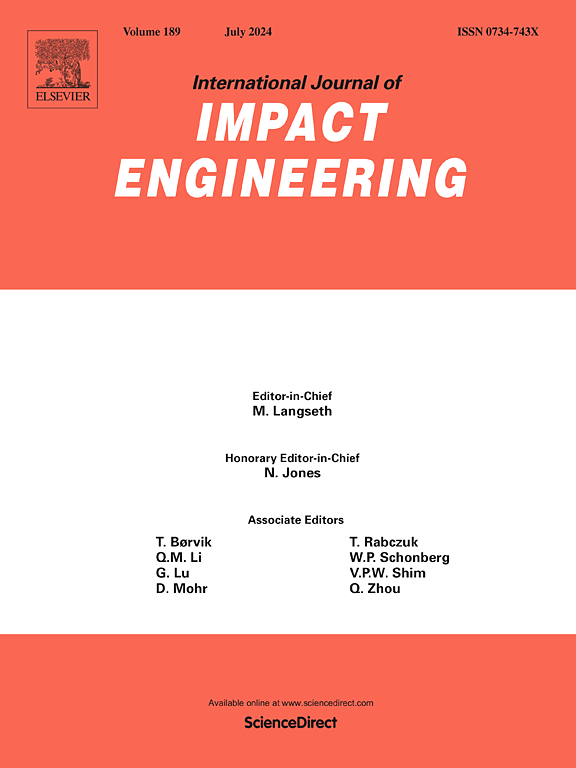Investigation of concrete constitutive models for predicting the response, damage, and residual capacity of reinforced concrete beams subject to low velocity impact
IF 5.1
2区 工程技术
Q1 ENGINEERING, MECHANICAL
International Journal of Impact Engineering
Pub Date : 2025-03-20
DOI:10.1016/j.ijimpeng.2025.105310
引用次数: 0
Abstract
Low velocity impact loading from accidental collisions is a common hazard for reinforced concrete components and structures used in infrastructure applications. Both the design of resilience measures and post-event forensic assessments of such structures can be supported using finite element analysis with advanced concrete constitutive models, however comparative benchmarking of available models to multiple experiments has been limited to date. This study comprehensively evaluates the performance of five concrete constitutive models – Continuous Surface Cap Model (CSCM), Karagozian and Case Concrete (KCC), Riedel–Hiermaier–Thoma (RHT), Concrete Damage Plasticity Model (CDPM), and Winfrith concrete – for analyzing the response of reinforced concrete beams to low-velocity impacts and the subsequent response of the damaged beam to static loading. The investigation includes simulation of five series of drop weight beam experiments conducted on reinforced concrete beams encompassing a range of reinforcement ratios, shear-to-flexural resistance ratios, and impact energies. The performance of each constitutive model is assessed based on comparisons with experimentally observed displacement time histories, damage patterns, and the load–displacement responses of the damaged beams under static loading. The results provide insight into the conditions under which each constitutive model replicates the experimental measurements with strong agreement when initialized with automatic parameter generation and default parameter assignments, while also identifying significant discrepancies in the nature and extent of damage predicted when using each model. This study highlights the importance of concrete constitutive model selection for accurate impact simulation and offers practical guidance for engineers and researchers in choosing appropriate constitutive models for assessing the response of reinforced concrete structures under impact loading.
预测低速冲击下钢筋混凝土梁的响应、损伤和剩余承载力的混凝土本构模型研究
意外碰撞产生的低速冲击载荷是基础设施中使用的钢筋混凝土构件和结构的常见危害。使用先进的混凝土本构模型进行有限元分析,可以支持弹性措施的设计和对此类结构的事后法医评估,然而,迄今为止,对多个实验的可用模型进行比较基准测试是有限的。本研究综合评估了五种混凝土本构模型的性能——连续表面帽模型(CSCM)、Karagozian和Case混凝土(KCC)、Riedel-Hiermaier-Thoma (RHT)、混凝土损伤塑性模型(CDPM)和winfrwith混凝土——用于分析钢筋混凝土梁对低速冲击的响应以及受损梁对静载荷的后续响应。该研究包括在钢筋混凝土梁上进行的五个系列的落锤梁实验的模拟,包括一系列的配筋率,剪切-弯曲阻力比和冲击能量。每个本构模型的性能是基于与实验观察位移时程、损伤模式和静态加载下受损梁的荷载-位移响应的比较来评估的。结果提供了洞察条件下,每个本构模型复制实验测量时,与自动参数生成和默认参数赋值的强烈一致性初始化,同时也确定了使用每个模型时,在性质和损害程度预测显著差异。本研究强调了混凝土本构模型选择对于准确的冲击模拟的重要性,为工程师和研究人员选择合适的本构模型来评估钢筋混凝土结构在冲击荷载作用下的响应提供了实践指导。
本文章由计算机程序翻译,如有差异,请以英文原文为准。
求助全文
约1分钟内获得全文
求助全文
来源期刊

International Journal of Impact Engineering
工程技术-工程:机械
CiteScore
8.70
自引率
13.70%
发文量
241
审稿时长
52 days
期刊介绍:
The International Journal of Impact Engineering, established in 1983 publishes original research findings related to the response of structures, components and materials subjected to impact, blast and high-rate loading. Areas relevant to the journal encompass the following general topics and those associated with them:
-Behaviour and failure of structures and materials under impact and blast loading
-Systems for protection and absorption of impact and blast loading
-Terminal ballistics
-Dynamic behaviour and failure of materials including plasticity and fracture
-Stress waves
-Structural crashworthiness
-High-rate mechanical and forming processes
-Impact, blast and high-rate loading/measurement techniques and their applications
 求助内容:
求助内容: 应助结果提醒方式:
应助结果提醒方式:


